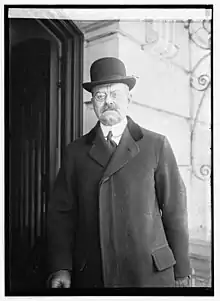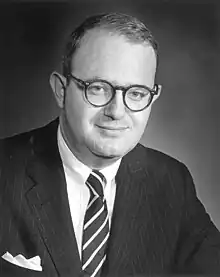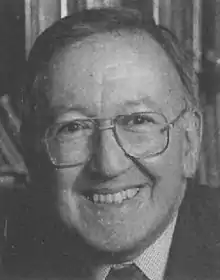List of ambassadors of the United States to Yugoslavia
The nation of Yugoslavia was formed on December 1, 1918 as a result of the realignment of nations and national boundaries in Europe in the aftermath of World War I. The nation was first named the Kingdom of Serbs, Croats and Slovenes and was renamed the Kingdom of Yugoslavia in 1929. The kingdom occupied the area in the Balkans comprising the present-day states of Bosnia and Herzegovina, Serbia, Montenegro, North Macedonia, and most of present-day Slovenia and Croatia. The United States recognized the newly formed nation and commissioned its first envoy to the kingdom on July 17, 1919. Previously the U.S. had had an envoy extraordinary and minister plenipotentiary who was commissioned to Romania, Bulgaria, and Serbia while resident in Bucharest, Romania. Towards the end of the 1930s, the diplomatic relations between Belgrade and Washington were raised from ministerial to the ambassadorial level.
| Ambassador of the United States to Yugoslavia | |
|---|---|
 Seal of the United States Department of State | |
Incumbent None | |
| Nominator | The President of the United States |
| Inaugural holder | Henry Percival Dodge as Envoy Extraordinary and Minister Plenipotentiary |
| Formation | July 17, 1919 |
| Abolished | February 4, 2003 (as Yugoslavia) February 29, 2004 (as Serbia and Montenegro) |
At the beginning of World War II, the government of Yugoslavia fled Belgrade and formed a government in exile in London and later in Cairo. During that time the U.S. ambassadors continued to represent the United States in London and Cairo. The embassy was transferred back to Belgrade in 1945.
Between 1943 and 1992 the nation was known by various names, including the Democratic Federative Yugoslavia (1943), the Federal People's Republic of Yugoslavia (1946), and the Socialist Federal Republic of Yugoslavia (1963).
After the breakup of the Socialist Federal Republic of Yugoslavia in 1992, the remnants of the nation, comprising the republics of Serbia and Montenegro, constituted a new state known as the Federal Republic of Yugoslavia. On May 21, 1992, the United States announced that it did not recognize the Federal Republic. The ambassador had left Belgrade one week earlier. A series of chargés d'affaires represented the U.S. government until 1999, when the embassy was closed.
In 2001 the United States recognized the Federal Republic of Yugoslavia and commissioned an ambassador to Belgrade.
In 2003 the parliament of the Federal Republic of Yugoslavia ratified the Constitutional Charter, establishing a new state union and changing the name of the country from Yugoslavia to Serbia and Montenegro. The U.S. ambassador continued in his post as the ambassador to Serbia and Montenegro.
For ambassadors to Serbia before and after Yugoslavia, see United States Ambassador to Serbia.
Ambassadors
|
U.S. diplomatic terms |
|---|
|
Career FSO After 1915, The United States Department of State began classifying ambassadors as career Foreign Service Officers (FSOs) for those who have served in the Foreign Service for a specified amount of time. Political appointee A person who is not a career foreign service officer, but is appointed by the president (often as a reward to political friends). Appointed The date that the ambassador took the oath of office; also known as "commissioning". It follows confirmation of a presidential appointment by the Senate, or a Congressional recess appointment by the president. In the case of a recess appointment, the ambassador requires subsequent confirmation by the Senate to remain in office. Presented credentials The date that the ambassador presented his letter of credence to the head of state or appropriate authority of the receiving nation. At this time the ambassador officially becomes the representative of his country. This would normally occur a short time after the ambassador's arrival on station. The host nation may reject the ambassador by not receiving the ambassador's letter, but this occurs only rarely. Terminated mission Usually the date that the ambassador left the country. In some cases a letter of recall is presented, ending the ambassador's commission, either as a means of diplomatic protest or because the diplomat is being reassigned elsewhere and replaced by another envoy. Chargé d'affaires The person in charge of the business of the embassy when there is no ambassador commissioned to the host country. Ad interim Latin phrase meaning "for the time being", "in the meantime". |
| Image | Name | Title | Appointed | Presented credentials | Terminated mission | Notes |
|---|---|---|---|---|---|---|
 |
Henry Percival Dodge[1] – Career FSO | Envoy Extraordinary and Minister Plenipotentiary | July 17, 1919 | October 5, 1919 | March 21, 1926 | |
 |
John Dyneley Prince[2] – Political appointee | February 23, 1926 | May 5, 1926 | August 31, 1932 | ||
| Charles S. Wilson[3][4] – Career FSO | August 3, 1933 | September 11, 1933 | July 28, 1937 | |||
 |
Arthur Bliss Lane – Career FSO | August 9, 1937 | October 23, 1937 | May 17, 1941[5] | ||
 |
Anthony J. Drexel Biddle, Jr.[6][7] – Political appointee | Ambassador Extraordinary and Plenipotentiary | July 30, 1941 | October 3, 1941 | September 28, 1943[8] | Promoted to Ambassador Extraordinary and Plenipotentiary September 1942 |
| Lincoln MacVeagh[9][10] – Political appointee | November 12, 1943 | December 9, 1943 | March 11, 1944[11] | |||
| Richard C. Patterson, Jr.[12] – Political appointee | September 21, 1944 | November 17, 1944 | Left Belgrade October 25, 1946 | |||
| Cavendish W. Cannon – Career FSO | April 10, 1947 | July 14, 1947 | October 19, 1949 | |||
 |
George V. Allen[13] – Career FSO | October 27, 1949 | January 25, 1950 | March 11, 1953 | ||
 |
James Williams Riddleberger – Career FSO | July 31, 1953 | November 16, 1953 | January 11, 1958 | ||
.jpg.webp) |
Karl L. Rankin[14] – Career FSO | December 13, 1957 | February 19, 1958 | April 22, 1961 | ||
 |
George F. Kennan – Career FSO | March 7, 1961 | May 16, 1961 | July 28, 1963 | ||
 |
Charles Burke Elbrick – Career FSO | January 29, 1964 | March 17, 1964 | April 28, 1969 | ||
| William Leonhart[15] – Career FSO | May 1, 1969 | June 30, 1969 | October 18, 1971 | |||
 |
Malcolm Toon – Career FSO | October 7, 1971 | October 23, 1971 | March 11, 1975 | ||
 |
Laurence H. Silberman - Political appointee | May 8, 1975 | May 26, 1975 | December 26, 1976 | ||
.jpg.webp) |
Lawrence S. Eagleburger – Career FSO | June 8, 1977 | June 21, 1977 | January 24, 1981 | ||
| David Anderson – Career FSO | July 27, 1981 | August 19, 1981 | June 26, 1985 | |||
| John Douglas Scanlan – Career FSO | July 12, 1985 | July 26, 1985 | March 6, 1989 | |||
 |
Warren Zimmermann – Career FSO | July 11, 1988 | March 21, 1989 | May 16, 1992 | The United States announced on May 21, 1992, that it would not recognize the Federal Republic of Yugoslavia, comprising the republics of Serbia and Montenegro, as the successor to the Socialist Federal Republic of Yugoslavia. | |
 |
Robert Rackmales | Chargés d'affaires ad interim | May 1992 | N/A | July 1993 | |
 |
Rudolf V. Perina | July 1993 | N/A | February 1996 | ||
 |
Lawrence Butler | February 1996 | N/A | August 1996 | ||
 |
Richard M. Miles | August 1996 | N/A | March 1999 | The embassy was closed March 23, 1999. Miles and the last Embassy personnel left March 24, and NATO armed forces began military action against Serbia-Montenegro that evening. | |
 |
William Dale Montgomery[16] – Career FSO | Ambassador Extraordinary and Plenipotentiary | November 26, 2001 | January 4, 2002 | February 29, 2004 | The United States again recognized the Federal Republic of Yugoslavia in 2001 and posted an ambassador to that nation. |
Montgomery was the last ambassador sent by the U.S. to a state known as Yugoslavia. Hereafter ambassadors in Belgrade were commissioned to Serbia and Montenegro until 2006, and then to Serbia onward. For subsequent ambassadors in Belgrade, see United States Ambassador to Serbia.
See also
- Socialist Federal Republic of Yugoslavia
- Federal Republic of Yugoslavia
- United States Ambassador to Bosnia and Herzegovina
- United States Ambassador to Croatia
- United States Ambassador to Macedonia
- United States Ambassador to Montenegro
- United States Ambassador to Serbia
- United States Ambassador to Slovenia
Notes
- Dodge was commissioned to the Kingdom of the Serbs, Croats, and Slovenes.
- Prince was commissioned to the Kingdom of the Serbs, Croats, and Slovenes and continued to serve as ambassador after the nation was renamed the Kingdom of Yugoslavia in 1929.
- Wilson was commissioned during a recess of the Senate and recommissioned after confirmation on January 15, 1934.
- Wilson was commissioned to the Kingdom of Yugoslavia.
- The king had fled Belgrade on April 14, 1941 in anticipation of a German invasion.
- Biddle served near the Yugoslav government-in-exile in England.
- Biddle was also commissioned to the governments-in-exile of Belgium, Czechoslovakia, Greece, Luxembourg, Netherlands, Norway, and Poland; resident in London.
- The government-in-exile of Yugoslavia transferred to Cairo September 28, 1943.
- MacVeagh served near the Yugoslav government-in-exile in Cairo.
- MacVeagh was also commissioned to the government-in-exile of Greece; resident in Cairo.
- The government-in-exile of Yugoslavia transferred back to England on March 11, 1944. On July 1, 1944 Rudolf E. Schoenfeld was designated Chargé d'Affaires ad interim near the Government of Yugoslavia established in England.
- Patterson served near the government-in-exile in London. The U.S. Embassy was transferred back to Belgrade March 31, 1945.
- Allen was commissioned during a recess of the Senate and recommissioned after confirmation on February 2, 1950.
- Rankin was commissioned during a recess of the Senate and recommissioned after confirmation on January 29, 1968.
- Leonhart was commissioned to the Socialist Federal Republic of Yugoslavia.
- Montgomery was originally commissioned to the Federal Republic of Yugoslavia and continued to serve after its name was changed to Serbia and Montenegro on February 4, 2003.
References
- United States Dep’t of State: Background notes on Serbia
- United States Dep’t of State: Ambassadors to Yugoslavia
- United States Dep’t of State: Ambassadors to Serbia and Montenegro
 This article incorporates public domain material from U.S. Bilateral Relations Fact Sheets. United States Department of State.
This article incorporates public domain material from U.S. Bilateral Relations Fact Sheets. United States Department of State.